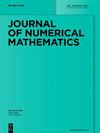变聚合物密度两相Oldroyd-B型模型的收敛格式
IF 4
2区 数学
Q1 MATHEMATICS
引用次数: 2
摘要
摘要本文研究了一种描述变粒子密度的稀聚合物溶液两相流动的扩散界面模型。由流体变形引起的聚合物伸长引起的附加应力用克莱默斯应力张量来描述。Kramers应力张量的演化由Oldroyd-B型方程与Navier-Stokes型方程、Cahn-Hilliard型方程和抛物型粒子密度方程耦合来模拟。给出了该模型的正则化有限元近似,证明了该格式是能量稳定的,并且存在离散解。此外,在等质量密度和二维空间的情况下,当正则化参数和时空离散化参数趋于零时,我们能够严格地通过极限,并证明了离散解的子序列收敛于非正则耦合系统的全局时间弱解。据我们所知,这是粘弹性流体两相流模型第一次用oldyd - b型方程求解的存在性结果。此外,我们证明了我们的有限元方案是完全实用的,并给出了数值模拟。本文章由计算机程序翻译,如有差异,请以英文原文为准。
On convergent schemes for a two-phase Oldroyd-B type model with variable polymer density
Abstract The paper is concerned with a diffuse-interface model that describes two-phase flow of dilute polymeric solutions with a variable particle density. The additional stresses, which arise by elongations of the polymers caused by deformations of the fluid, are described by Kramers stress tensor. The evolution of Kramers stress tensor is modeled by an Oldroyd-B type equation that is coupled to a Navier–Stokes type equation, a Cahn–Hilliard type equation, and a parabolic equation for the particle density. We present a regularized finite element approximation of this model, prove that our scheme is energy stable and that there exist discrete solutions to it. Furthermore, in the case of equal mass densities and two space dimensions, we are able to pass to the limit rigorously as the regularization parameters and the spatial and temporal discretization parameters tend towards zero and prove that a subsequence of discrete solutions converges to a global-in-time weak solution to the unregularized coupled system. To the best of our knowledge, this is the first existence result for a two-phase flow model of viscoelastic fluids with an Oldroyd-B type equation. Additionally, we show that our finite element scheme is fully practical and we present numerical simulations.
求助全文
通过发布文献求助,成功后即可免费获取论文全文。
去求助
来源期刊
CiteScore
5.90
自引率
3.30%
发文量
17
审稿时长
>12 weeks
期刊介绍:
The Journal of Numerical Mathematics (formerly East-West Journal of Numerical Mathematics) contains high-quality papers featuring contemporary research in all areas of Numerical Mathematics. This includes the development, analysis, and implementation of new and innovative methods in Numerical Linear Algebra, Numerical Analysis, Optimal Control/Optimization, and Scientific Computing. The journal will also publish applications-oriented papers with significant mathematical content in computational fluid dynamics and other areas of computational engineering, finance, and life sciences.

 求助内容:
求助内容: 应助结果提醒方式:
应助结果提醒方式:


